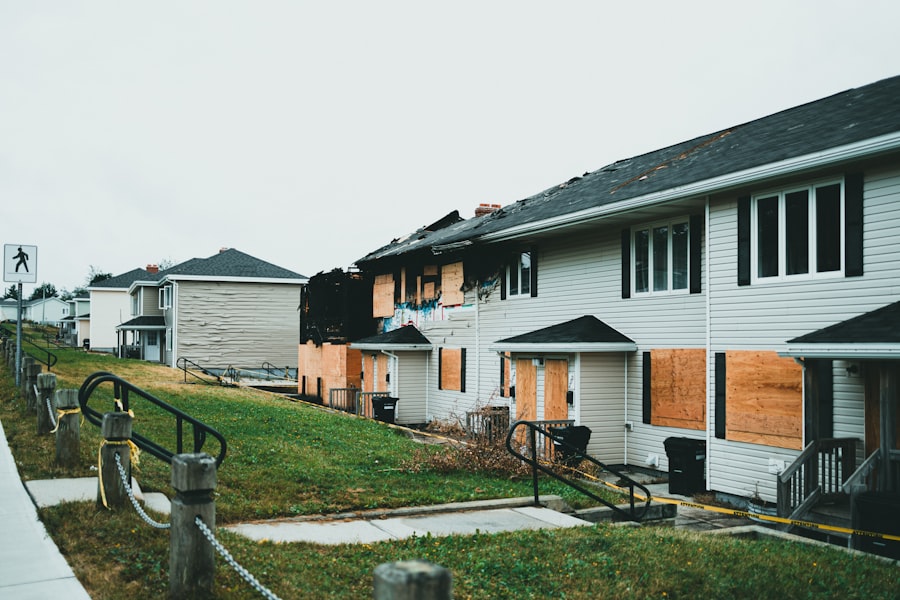The Housing Market Crash of 2008 stands as a pivotal moment in economic history, a stark reminder of the fragility of financial systems and the profound impact they can have on everyday lives. As you delve into this topic, you will uncover the intricate web of factors that led to this catastrophic event, which not only affected homeowners but also reverberated through global economies. The crash was not merely a sudden downturn; it was the culmination of years of reckless lending practices, speculative investments, and a lack of regulatory oversight.
Understanding this crash is essential for grasping the complexities of modern finance and the housing market. As you explore the events leading up to the crash, you will find that it was characterized by an unprecedented rise in housing prices, fueled by easy credit and a booming economy. However, this growth was built on shaky foundations.
When the bubble burst, it sent shockwaves through the financial system, leading to widespread foreclosures and a significant decline in home values. The repercussions were felt far beyond the housing market, affecting employment rates, consumer confidence, and overall economic stability. This article aims to dissect the various elements that contributed to this crisis and its lasting effects on society.
Key Takeaways
- The 2008 housing market crash was triggered by a combination of risky lending practices and financial institution failures.
- Subprime mortgages played a central role in destabilizing the housing market and leading to widespread foreclosures.
- Government policies and regulatory shortcomings contributed to the severity of the crisis.
- The crash had profound impacts on homeowners, communities, and the global economy.
- Lessons from the crash have informed recovery efforts and strategies to prevent future housing market collapses.
Factors Contributing to the Housing Market Crash
Several interrelated factors contributed to the Housing Market Crash of 2008, each playing a crucial role in creating an environment ripe for disaster. One of the primary drivers was the proliferation of subprime mortgages, which allowed individuals with poor credit histories to purchase homes. These loans often came with high-interest rates and unfavorable terms, making them unsustainable for many borrowers.
As you consider this aspect, it becomes clear that the accessibility of credit was both a blessing and a curse, enabling homeownership for some while setting others up for failure. Another significant factor was the rampant speculation in real estate. Investors began purchasing properties not to live in them but to flip them for quick profits.
This speculative behavior drove home prices to unsustainable levels, creating an artificial demand that masked underlying economic weaknesses. As you reflect on this phenomenon, you may recognize how it mirrors other bubbles throughout history, where greed and short-term thinking overshadowed prudent financial practices. The combination of easy credit and speculative investments created a perfect storm that ultimately led to the collapse of the housing market.
Subprime Mortgage Crisis

At the heart of the Housing Market Crash lies the subprime mortgage crisis, a situation that emerged when lenders began offering high-risk loans to borrowers with questionable creditworthiness. As you examine this crisis, you will see how these subprime mortgages were often bundled into complex financial products known as mortgage-backed securities (MBS). Investors were drawn to these securities due to their seemingly high returns, unaware of the underlying risks associated with the loans they contained.
This lack of transparency contributed significantly to the eventual collapse. As defaults on subprime mortgages began to rise, it became evident that many borrowers were unable to meet their payment obligations. The resulting wave of foreclosures flooded the market with homes, driving prices down and creating a vicious cycle that further exacerbated the crisis.
You may find it alarming how quickly the situation spiraled out of control, as financial institutions faced massive losses and confidence in the housing market eroded. The subprime mortgage crisis serves as a cautionary tale about the dangers of predatory lending practices and the importance of responsible borrowing.
Role of Financial Institutions in the Housing Market Crash
| Financial Institution | Role in Housing Market Crash | Impact on Housing Market | Key Metrics |
|---|---|---|---|
| Mortgage Lenders | Issued high-risk subprime mortgages | Increased default rates and foreclosures | Subprime mortgage origination rose from 8% to 20% (2000-2006) |
| Investment Banks | Securitized mortgages into mortgage-backed securities (MBS) | Spread risk throughout financial system | MBS issuance grew from 500 billion to 2 trillion (2000-2007) |
| Credit Rating Agencies | Assigned high ratings to risky mortgage securities | Misled investors about risk levels | Over 80% of subprime MBS rated AAA before crash |
| Commercial Banks | Provided loans and credit lines to mortgage lenders | Increased leverage and exposure to housing market | Leverage ratios increased from 10:1 to 30:1 (2000-2007) |
| Government-Sponsored Enterprises (GSEs) | Purchased and guaranteed mortgage-backed securities | Encouraged expansion of mortgage lending | GSE mortgage purchases grew from 1 trillion to 5 trillion (2000-2007) |
Financial institutions played a pivotal role in both facilitating and exacerbating the Housing Market Crash. As you explore their involvement, you will discover how banks and mortgage lenders aggressively marketed subprime loans, often prioritizing profit over responsible lending practices. Many institutions engaged in predatory lending, targeting vulnerable populations with loans that they could not realistically afford.
This behavior not only contributed to individual financial ruin but also destabilized entire communities. Moreover, financial institutions were heavily involved in creating and selling mortgage-backed securities. By pooling together thousands of mortgages and selling them as investment products, banks spread risk across a wide array of investors.
However, this practice also obscured the true risk associated with these securities, leading many investors to underestimate their exposure to potential defaults. As you consider this aspect, it becomes clear that a lack of accountability and transparency within financial institutions played a significant role in precipitating the crash.
Government Policies and Regulations
Government policies and regulations also significantly influenced the trajectory of the housing market leading up to 2008. In an effort to promote homeownership, various federal initiatives encouraged lending practices that ultimately contributed to the crisis. For instance, government-sponsored enterprises like Fannie Mae and Freddie Mac played a crucial role in expanding access to credit by purchasing mortgages from lenders.
While their intentions were noble, these policies inadvertently incentivized risky lending practices that undermined financial stability. In addition to promoting homeownership, regulatory oversight was lacking during this period. You may find it concerning how regulatory bodies failed to recognize or address the growing risks within the housing market.
The absence of stringent regulations allowed financial institutions to engage in reckless behavior without fear of repercussions. As you reflect on this aspect, it becomes evident that effective regulation is essential for maintaining stability within financial markets and protecting consumers from predatory practices.
Impact on Homeowners and Communities

The impact of the Housing Market Crash on homeowners and communities was profound and far-reaching. As home values plummeted, many individuals found themselves underwater on their mortgages—owing more than their homes were worth. This situation led to widespread foreclosures, displacing families and leaving neighborhoods in disarray.
You may feel a sense of empathy as you consider the emotional toll this took on countless individuals who had invested their hopes and dreams into homeownership. Communities also suffered as foreclosures increased and property values declined. Neighborhoods once filled with pride and stability became shadowed by vacant homes and declining property conditions.
The social fabric of these communities frayed as families were uprooted and local businesses struggled due to decreased consumer spending. As you contemplate these consequences, it becomes clear that the effects of the crash extended far beyond individual homeowners; entire communities were left grappling with economic hardship and social dislocation.
Global Economic Consequences
The repercussions of the Housing Market Crash were not confined to the United States; they rippled across global economies, highlighting the interconnectedness of modern finance. As financial institutions faced mounting losses from mortgage-backed securities, confidence in markets plummeted worldwide. You may find it striking how quickly what began as a domestic crisis escalated into a global economic downturn, affecting countries far removed from the initial epicenter.
International markets experienced significant turmoil as investors pulled back from riskier assets and sought safer havens for their capital. This flight to safety led to liquidity shortages and increased volatility across various sectors. Additionally, countries heavily reliant on exports faced declining demand as consumer spending contracted in response to economic uncertainty.
As you reflect on these global consequences, it becomes evident that the interconnected nature of financial systems means that crises can have far-reaching implications beyond national borders.
Lessons Learned from the Housing Market Crash
The Housing Market Crash of 2008 offers valuable lessons for policymakers, financial institutions, and consumers alike. One key takeaway is the importance of responsible lending practices and transparency within financial markets.
Financial literacy initiatives can empower consumers to make informed decisions about homeownership and borrowing. Another critical lesson is the need for robust regulatory oversight to mitigate systemic risks within financial systems. You may recognize that while some regulations may seem burdensome, they serve as safeguards against reckless behavior that can lead to widespread economic instability.
Striking a balance between promoting access to credit and ensuring responsible lending practices is vital for maintaining a healthy housing market.
Recovery and Rebuilding Efforts
In the aftermath of the Housing Market Crash, recovery efforts began as communities sought to rebuild and restore stability. You may find it inspiring how various stakeholders—government agencies, non-profit organizations, and private sector entities—came together to address the challenges posed by foreclosures and declining property values. Initiatives aimed at providing assistance to struggling homeowners emerged, offering loan modifications and foreclosure prevention programs.
Additionally, urban revitalization efforts gained momentum as communities worked to reclaim neighborhoods affected by disinvestment. You might appreciate how these efforts not only focused on restoring physical structures but also aimed at fostering social cohesion and economic opportunity within communities. The road to recovery was long and arduous, but it demonstrated resilience in the face of adversity.
Current State of the Housing Market
As you examine the current state of the housing market, you will find that it has undergone significant changes since the crash of 2008. While home prices have rebounded in many areas, concerns about affordability persist as wages have not kept pace with rising housing costs. You may notice how this disparity has led to increased discussions about housing policy reform aimed at ensuring equitable access to homeownership for all individuals.
Moreover, lessons learned from past mistakes have prompted greater scrutiny of lending practices and regulatory frameworks within the housing market. Financial institutions are now more cautious in their lending approaches, emphasizing responsible underwriting standards to prevent another crisis from occurring. As you reflect on these developments, it becomes clear that while progress has been made, ongoing vigilance is necessary to maintain stability within the housing market.
Preventing Future Housing Market Crashes
To prevent future housing market crashes, a multifaceted approach is essential—one that encompasses responsible lending practices, effective regulation, and increased consumer education.
Additionally, fostering financial literacy among consumers can empower individuals to make informed decisions about homeownership and borrowing.
By equipping people with knowledge about mortgage products and potential risks associated with homeownership, we can create a more resilient housing market that prioritizes long-term stability over short-term gains. In conclusion, understanding the Housing Market Crash of 2008 is crucial for navigating today’s economic landscape. By learning from past mistakes and implementing proactive measures, we can work towards building a more stable housing market that benefits all members of society while safeguarding against future crises.
The housing market crash of 2008 had profound implications for the economy and personal finances, leading many to reassess their investment strategies. For a deeper understanding of how such market fluctuations can impact wealth accumulation, you can explore the article on wealth growth strategies at How Wealth Grows. This resource provides valuable insights into navigating financial challenges and making informed decisions in the wake of economic downturns.
FAQs
What caused the housing market crash in 2008?
The 2008 housing market crash was primarily caused by a combination of factors including widespread subprime mortgage lending, excessive risk-taking by financial institutions, inflated housing prices, and the collapse of mortgage-backed securities. These elements led to a sharp decline in home values and a surge in mortgage defaults.
How did subprime mortgages contribute to the 2008 crash?
Subprime mortgages were loans given to borrowers with poor credit histories who were more likely to default. Lenders issued these high-risk loans in large numbers, often with adjustable rates that increased over time. When many subprime borrowers began to default, it triggered a chain reaction that destabilized the housing market and financial institutions.
What role did mortgage-backed securities play in the crash?
Mortgage-backed securities (MBS) are financial products made up of bundled home loans. Many MBS included risky subprime mortgages. When homeowners defaulted on their loans, the value of these securities plummeted, causing significant losses for banks and investors, which contributed to the financial crisis.
How did the housing market crash affect the broader economy?
The crash led to a severe credit crunch, causing banks to tighten lending standards. This resulted in reduced consumer spending and business investment, leading to a recession. Millions of people lost their homes, jobs, and savings, and the global economy experienced widespread financial instability.
What government actions were taken in response to the 2008 housing market crash?
Governments and central banks worldwide implemented emergency measures including bailouts of financial institutions, lowering interest rates, and stimulus packages to stabilize the economy. In the U.S., the Troubled Asset Relief Program (TARP) was introduced to purchase toxic assets and support banks.
Has the housing market recovered since the 2008 crash?
Yes, the housing market has largely recovered since 2008. Home prices have rebounded in many areas, and lending standards have tightened to prevent a repeat of the crisis. However, the crash led to lasting changes in financial regulations and mortgage lending practices.
What lessons were learned from the 2008 housing market crash?
Key lessons include the importance of responsible lending, the risks of excessive financial leverage, the need for transparency in financial products, and the critical role of regulatory oversight to prevent systemic risks in the housing and financial markets.
